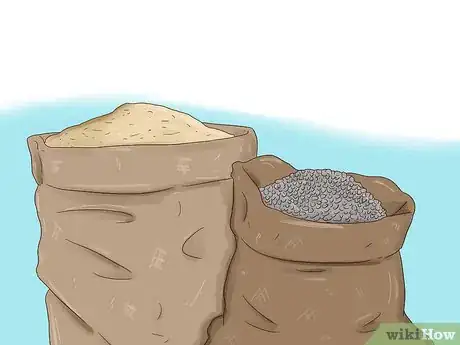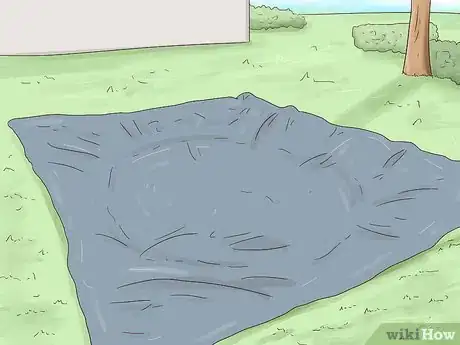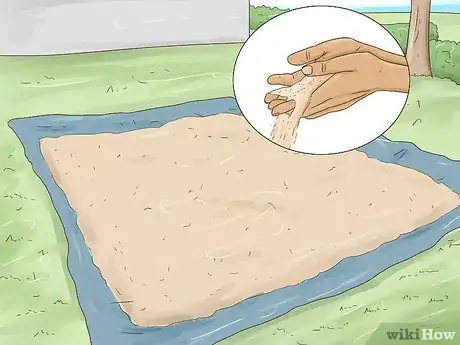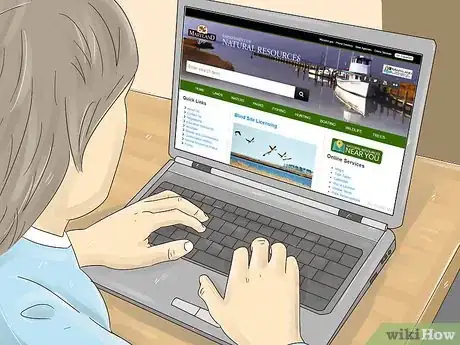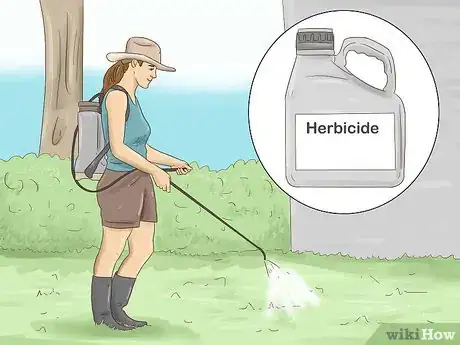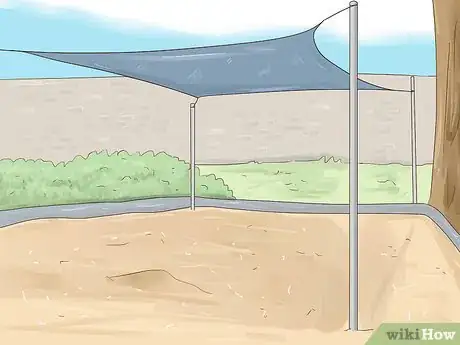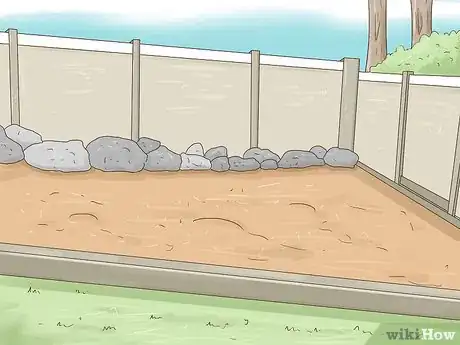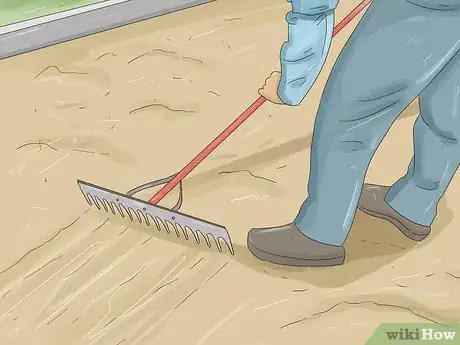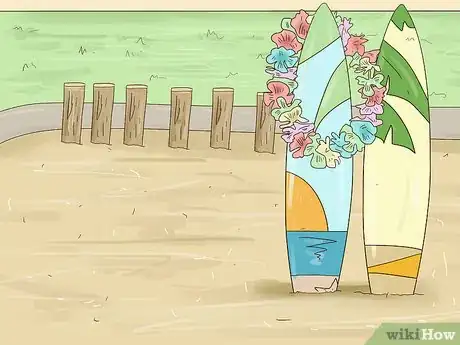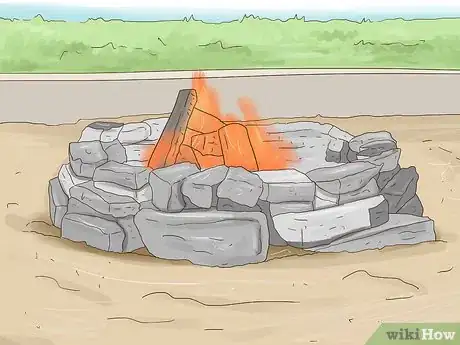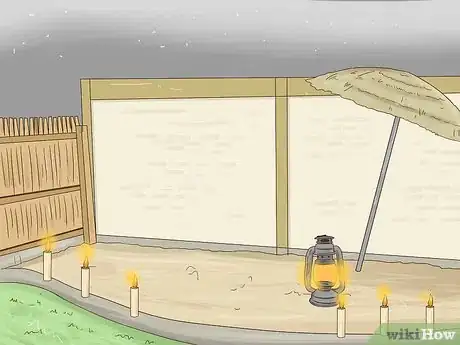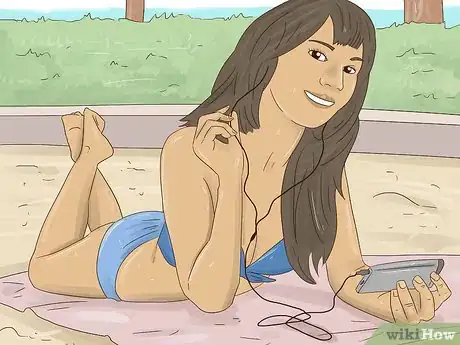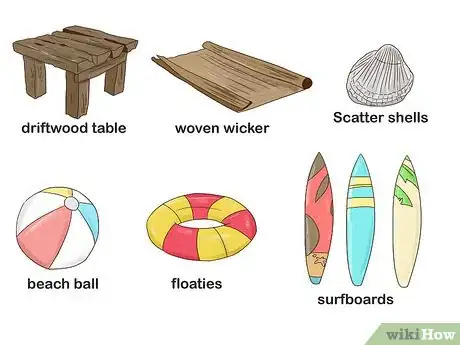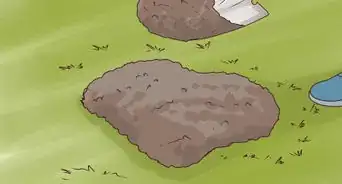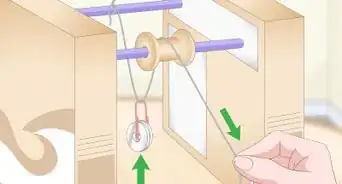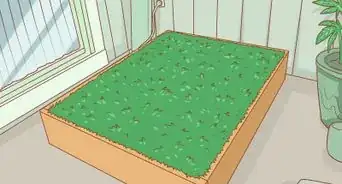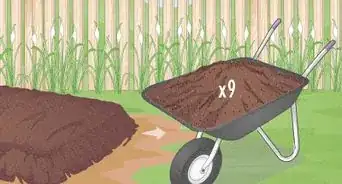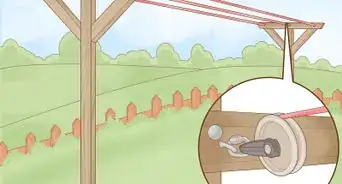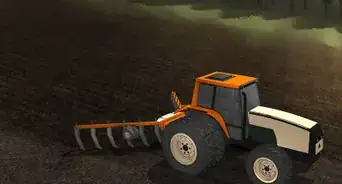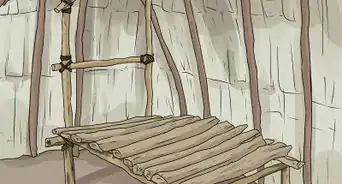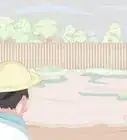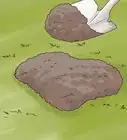This article was co-authored by wikiHow Staff. Our trained team of editors and researchers validate articles for accuracy and comprehensiveness. wikiHow's Content Management Team carefully monitors the work from our editorial staff to ensure that each article is backed by trusted research and meets our high quality standards.
There are 8 references cited in this article, which can be found at the bottom of the page.
This article has been viewed 141,435 times.
Learn more...
Can't make the trek to the beach? Not a problem -- bring it to your own home! Whether you want to build in your backyard or next to a pond or lake on your property, the beach can be moments away, winter, spring, summer, or fall.
Steps
Making a Beach in Your Backyard
-
1Pull weeds and measure the length and width of the beach area. Get your garden tools and remove all plants from the area you’ll be putting in your beach. Once the area is clear, use your tape measure to determine its length and width.
- It may be easiest to use a shovel to remove the top layer of plants or till the greenery under the surface of the soil.[1]
- If you plan on hanging a traditional hammock, this is the perfect time to dig some postholes and sink a sturdy wooden 4x4 board.[2]
-
2Purchase sand and gravel. Gravel will form the base of your beach area and can be shaped to add a dune-like contour. The amount you’ll need will depend on the amount of contour you desire. Where sand’s concerned, you’ll need enough to cover the entire area at least 6 in (15.2 cm) deep.
- Beach or mortar sand work best and are widely available. Decomposed granite can also work as your base and is easy to mold into dunes.
- If you’re unsure how much sand you’ll need, input the length, width, and depth of your planned beach area into an online sand calculator. This number is usually in cubic yards or meters.
Advertisement -
3Add a plastic liner to deter plant growth. If you don’t put down a liner, over time plants will invade your beach area, even if you were really careful when weeding. You can pull these up as they push through the sand, but a plastic liner will make plant invasions all but nonexistent.[3]
-
4Spread the gravel on the liner. If you want a level beach area, rake an even layer of gravel onto the plastic liner. Heap up small hills so that when it’s covered with sand it looks like sand dunes. When you’ve got the contour just right, spray it liberally with water and let it sit overnight.
- Hosing down the gravel base will harden it, making it more stable. To prevent too much sand from falling into gaps in the gravel, use a little potting soil to fill gaps and holes after the gravel dries.[4]
-
5Finish your backyard beach with a layer of sand. Spread sand evenly over the entire area, though you may want to add some extra to high traffic areas or play areas. This will prevent the gravel from being exposed and make your backyard beach more realistic.
- If you haven’t plugged holes with potting soil, at first it may seem like sand is simply disappearing into the gravel. Keep layering it on until the sand is at least 6 in (15.2 cm) deep.
- Keep a rake set off to the side of your beach area so you can redistribute sand when necessary and keep a healthy layer over top the gravel beneath.
Adding a Beach to a Body of Water
-
1Verify you can build your beach. Some regions may have laws in place to protect the land surrounding bodies of water, even those that are manmade, like ponds. Check for restrictions like these with your local zoning board or Department of Natural Resources.
- You might ask about regulations saying something like, “Hi, I’m planning on adding a manmade beach to a pond on my property. Are there any laws or regulations I should be aware of moving forward?”
- You should inspect the area where you’ll build your beach thoroughly. Accidentally harming endangered plants or animals may still carry a stiff penalty.[5]
-
2Determine your method of weed control. If you only layer sand on the shoreline of your body of water, plants will eventually spring up and reclaim the area. Similar to a backyard beach, you can use a plastic liner to prevent plant growth beneath your sand.[6]
- As an alternative to the plastic liner, you can use regular applications of an herbicide to keep your beach looking sandy and pristine.
- Some regions have laws against using a liner (or other kinds of plant barriers) underneath a fresh layer of top-sand.[7]
-
3Purchase large-grained sand. Generally, you’ll want the largest grain beach or mortar sand you can get. Outdoors, sand is more likely to be blown around your property or washed to the bottom of the body of water. Large-grained sand will be less likely to migrate away from your planned beach area.
- For most outdoor beaches, you should plan to cover it in at least 6 in (15.2 cm) of sand, but do not exceed more than 18 in (45.7 cm).[8]
- There are products you can buy, like sand mats, that prevent weeds from growing and sand from being washed or blown away.
-
4Remove weeds. This may be a time consuming process if your beach area is large. A shovel, rake, and some elbow grease will eventually get the job done, but a rototiller, backhoe, or front loader will make weed removal a cinch.
- Rototillers, backhoes, and front loaders can be very expensive. Save some money by renting one of these when you need it from your local hardware store or home centers.
-
5Install shade cloth on the bare ground. Moisture and gasses in the soil and air can cause your sand to be absorbed into surrounding soil, especially clay. A shade cloth with prevent this from happening. Purchase shade cloths at hardware stores and home centers.[9]
-
6Create a short wall, curb, or barrier for your sand. Unless you have some kind of wall or barrier where your sand transitions to the natural bottom of the body of water, your sand will quickly be washed away. A concrete curb, landscape timber barrier, or cross tie boundary all work well for retaining sand.
- Be sure you clearly mark the retaining feature with buoys, flags, or similar things to prevent swimmers from stubbing toes or otherwise harming themselves.
-
7Add the sand and use a sand rake to maintain it. Now that all the prep work has been done, all you need to do spread out the sand. After that, rake the sand regularly with a sand rake (like the kinds used on golf courses) to prevent plant seeds from growing.
- If your sand becomes flat and hard, use a rototiller, hoe, or pickaxe to break it up a couple of times every year.
Decorating Your Beach Area
-
1Use surfboards, towels, and similar items to convey a tropical theme. You can also hang Hawaiian leis (flower necklaces) from chairs, surfboards, bannisters, and fence posts to get a tropical feel.
- To recreate a tropical beach setting, decorate with bright colors.
- Drape colorful beach towels from chairs or lay them out on the sand for sunbathing.
- Items made from wood, bamboo, and linen will add to the beachside vibe. Try to keep your theme cohesive and consistent.
-
2Grow beach plants. By growing plants common to beach areas on your beach, it will be even more realistic. You may be able to insert some plants right in the sand, but others might do best in a pot. Some plants to consider for your beach:
- Arthropodium cirratum (rengarenga lily)
- Astelia chathamica (Silver Spear)
- Austroderia (Toetoe)
- Carex virgata
- Frangipanis
- Yucca faxoniana (Spanish dagger)[10]
-
3Create a fire pit. As the sun sets and the temperature drops, many beach parties often turn into beach bonfires. Collect some rocks (or flagstones) and arrange these in a circle to create a fire pit.
- Depending on where you've built your beach, it may be easier and safer to set out a standalone metal fire pit or brazier.[11]
- In most areas, making a fire out in the open requires a burning permit. This should be available through your local government offices, like the clerk or fire department.
-
4Improve the ambiance of your beach area with lighting. Natural light should do most of the work for you during the day. But direct sunlight can be brutal. Offer some relief by setting up a canopy or sun umbrella.
- When darkness descends, light up your beach area with candles, lanterns, and Tiki torches. Use string lights to add a magical, fairy-light feel.[12]
-
5Make a sandbox on top of the beach with an inflatable pool. An inflatable pool will keep sand from spreading out in a thin layer, making this a perfect place to build sandcastles. If kids are around, they'll love it! Include a small bucket, plastic shovel, and other sandcastle making tools.
- If you’re not a fan of playing in the sand, why not fill the pool with a small amount of water to cool off your feet when the weather’s hot?
- Not a sandbox or pool fan? Use a decorative fountain instead. The sound of flowing water will have a calming effect.
-
6Play sounds of the beach with a playlist or music station. You should be able to find beach-themed tracks on YouTube or a music platform, like Spotify or Pandora. Many white noise makers have an “ocean sounds” track that you can use to evoke the sense of a nearby body of water even when your eyes are closed.
- Calypso and reggae are styles of music often associated with tropical climates.[13] Hook up some speakers and play this music to accompany your beach scene.
-
7Add finishing touches with beach themed items. Scatter shells on tables and use woven wicker mats for placemats. If you have a small piece of driftwood, you might use it as a table centerpiece. Larger pieces can be arranged around plants and rocks to make the scene appear freshly washed ashore.
- Beach toys scattered about, like beach balls, floaties, and surfboards, will give the impression of a fun beachside scene.[14]
Community Q&A
Did you know you can get answers researched by wikiHow Staff?
Unlock staff-researched answers by supporting wikiHow
-
QuestionWould a beach work well for a pond?
 wikiHow Staff EditorThis answer was written by one of our trained team of researchers who validated it for accuracy and comprehensiveness.
wikiHow Staff EditorThis answer was written by one of our trained team of researchers who validated it for accuracy and comprehensiveness.
Staff Answer wikiHow Staff EditorStaff AnswerA beach would be a great addition next to a pond and would provide an attractive transition from garden to water feature. One benefit would be the non-slip surface provided by sand as opposed to stones or grass, which could be slippery when wet. Another benefit is the lack of mud that would otherwise occur if the pond didn't have the sand surround. Just be sure that you have enough space to incorporate a beach as well as the pond though, as this does require a large area for it to be effective.
wikiHow Staff EditorStaff AnswerA beach would be a great addition next to a pond and would provide an attractive transition from garden to water feature. One benefit would be the non-slip surface provided by sand as opposed to stones or grass, which could be slippery when wet. Another benefit is the lack of mud that would otherwise occur if the pond didn't have the sand surround. Just be sure that you have enough space to incorporate a beach as well as the pond though, as this does require a large area for it to be effective. -
QuestionI have a lake on my property and would like to include a way of interacting with the water from the beach. Any suggestions?
 wikiHow Staff EditorThis answer was written by one of our trained team of researchers who validated it for accuracy and comprehensiveness.
wikiHow Staff EditorThis answer was written by one of our trained team of researchers who validated it for accuracy and comprehensiveness.
Staff Answer wikiHow Staff EditorStaff AnswerA pier, jetty or boardwalk structure would be an ideal way to bridge between the beach and water area. Start it on an area of the beach where it is easy to access and won't be in the way and extend it as far out as you can manage safely and within available resources. If you do boating activities on the lake, include a docking ramp and if it's stocked with fish, have a fishing area with seating and rod rests. Another option is a floating island made from barrels and pallets, which can be swum to from shore and rested upon.
wikiHow Staff EditorStaff AnswerA pier, jetty or boardwalk structure would be an ideal way to bridge between the beach and water area. Start it on an area of the beach where it is easy to access and won't be in the way and extend it as far out as you can manage safely and within available resources. If you do boating activities on the lake, include a docking ramp and if it's stocked with fish, have a fishing area with seating and rod rests. Another option is a floating island made from barrels and pallets, which can be swum to from shore and rested upon. -
QuestionWhere can I get the sand from for my beach?
 wikiHow Staff EditorThis answer was written by one of our trained team of researchers who validated it for accuracy and comprehensiveness.
wikiHow Staff EditorThis answer was written by one of our trained team of researchers who validated it for accuracy and comprehensiveness.
Staff Answer wikiHow Staff EditorStaff AnswerYour local hardware supplier should have river sand in packages, usually in the landscaping or garden areas. Do not collect sand from beaches, river edges or anywhere else, as this can damage the habitats and stability of natural areas. Ask your supplier if the sand has been sourced sustainably as sand is a precious commodity that is at risk of running out.
wikiHow Staff EditorStaff AnswerYour local hardware supplier should have river sand in packages, usually in the landscaping or garden areas. Do not collect sand from beaches, river edges or anywhere else, as this can damage the habitats and stability of natural areas. Ask your supplier if the sand has been sourced sustainably as sand is a precious commodity that is at risk of running out.
Warnings
- Be careful if you plan to use candles, Tiki torches, or anything else that has an open flame. Unattended or poorly placed flames could cause serious property damage or harm.⧼thumbs_response⧽
Things You'll Need
Making a Beach in Your Backyard
- Garden tools (like shovels, rakes, and a rototiller)
- Plastic liner
- Tape measure
- Sand
- Gravel
Adding a Beach to a Body of Water
- Garden tools (like shovels, rakes, and a rototiller)
- Herbicide (optional)
- Plastic liner (optional)
- Sand
- Sand rake
- Shade cloth
Decorating Your Beach Area
- Beach balls
- Beach towels
- Beachside plants (like arthropodium cirratum and astelia chathamica)
- Beachside sound effects (from a white noise maker or online playlist)
- Candles
- Hawaiian Leis (flower necklaces)
- Inflatable pool
- Lanterns
- Shells
- Stones (or standalone metal fire pit)
- Surfboards
- Tropical music (like Reggae and Calypso)
- Umbrellas
References
- ↑ https://www.australianoutdoorliving.com.au/how-to-make-your-own-backyard-beach/
- ↑ https://www.youtube.com/watch?v=BBUhk46rEMA
- ↑ https://www.australianoutdoorliving.com.au/how-to-make-your-own-backyard-beach/
- ↑ http://www.sunset.com/garden/landscaping-design/how-to-make-backyard-beach
- ↑ http://goneoutdoors.com/create-lakeside-beach-2124450.html
- ↑ https://www.australianoutdoorliving.com.au/how-to-make-your-own-backyard-beach/
- ↑ http://goneoutdoors.com/create-lakeside-beach-2124450.html
- ↑ http://www.livingthecountrylife.com/homes-acreages/ponds/build-a-beach-at-your-pond
- ↑ http://www.livingthecountrylife.com/homes-acreages/ponds/build-a-beach-at-your-pond
- ↑ http://www.stuff.co.nz/life-style/home-property/88928417/How-to-bring-the-beach-to-your-backyard
- ↑ http://www.sunset.com/garden/landscaping-design/how-to-make-backyard-beach
- ↑ https://www.leaffilter.com/blog/how-to-repairs/diy-crafts-projects/bring-the-beach-to-your-backyard/
- ↑ http://www.scaruffi.com/history/reggae.html
- ↑ http://www.stuff.co.nz/life-style/home-property/88928417/How-to-bring-the-beach-to-your-backyard
About This Article
To make a beach in your backyard, start by clearing away any debris and pulling out any weeds. Lay a plastic liner where you want your beach to be so no plants will grow through. Spread a layer of gravel on top of the liner. Then, spray it with lots of water and leave it overnight, which will harden the base. You can also add some potting soil on top, which will help prevent sand falling into gaps in the gravel. In the morning, add your sand on top and spread it out so it’s at least 6 inches thick all over. For more tips, including how to decorate your new beach area, read on!

